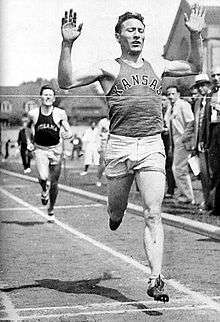Glenn Cunningham (athlete)
 Glenn Cunningham competing for KU circa 1933 | |||||||||||||
| Personal information | |||||||||||||
|---|---|---|---|---|---|---|---|---|---|---|---|---|---|
| Full name | Glenn Verniss Cunningham | ||||||||||||
| Nationality | American | ||||||||||||
| Born |
August 4, 1909 Atlanta, Kansas | ||||||||||||
| Died |
March 10, 1988 (aged 78) Menifee, Arkansas | ||||||||||||
| Height | 5'10 | ||||||||||||
| Weight | 154 lb (70 kg) | ||||||||||||
| Sport | |||||||||||||
| Country |
| ||||||||||||
| Sport | Track and field athletics | ||||||||||||
| Event(s) | 800m, 1500m, 1 mile | ||||||||||||
| Team | University of Kansas | ||||||||||||
| Retired | 1940 | ||||||||||||
| Achievements and titles | |||||||||||||
| Highest world ranking | 1st | ||||||||||||
Medal record
| |||||||||||||
Glenn Verniss Cunningham (August 4, 1909 – March 10, 1988) was an American distance runner and athlete considered by many the greatest American miler of all time. He received the James E. Sullivan Award as the top amateur athlete in the United States in 1933.
He was born in Atlanta, Kansas, but grew up in Elkhart, Kansas, to Henry Clinton Cunningham (September 20, 1877 – July 27, 1956) and Rosa Agnes Cunningham (née Moore; December 5, 1882 – March 1, 1961). Cunningham was nicknamed the "Kansas Flyer", the "Elkhart Express" and the "Iron Horse of Kansas". Cunningham's legs were very badly burned in an explosion caused when someone accidentally put gasoline instead of kerosene in the can at his schoolhouse when he was eight and his brother Floyd was thirteen. Floyd died in the fire. When the doctors recommended amputating Glenn's legs, he was so distressed his parents would not allow it. The doctors predicted he might never walk normally again. He had lost all the flesh on his knees and shins and all the toes on his left foot. Also, his transverse arch was practically destroyed. However, his great determination, coupled with hours upon hours of a new type of therapy, enabled him to gradually regain the ability to walk and to proceed to run. It was in the early summer of 1919 when he first tried to walk again, roughly two years after the accident. He had a positive attitude as well as a strong religious faith. His favorite Bible verse was Isaiah 40:31: "But those who wait on the Lord shall renew their strength; they shall mount up with wings like eagles, they shall run and not be weary, they shall walk and not faint."
He competed in both the 1932 Summer Olympics as well as the 1936 Summer Olympics. While on the ship traveling from the U.S. to Germany, he was voted "Most Popular Athlete" by his fellow Olympians.
Cunningham won the Sullivan medal in 1933 for his various running achievements in middle distance.
In the 1932 Olympics he took 4th place in the 1500 m, and in the 1936 Berlin Olympics, he took silver in the 1500 meters.
In 1934, he set the world record for the mile run at 4:06.8, which stood for three years.
In 1936, he set the world record in the 800 m run.
In 1938, he set a world record in the indoor mile run of 4:04.4. He retired from competition in 1940. (Roger Bannister was the first to break the four-minute mile, in 1954.)
Cunningham's goal—unachieved—was a four-minute mile. Many people tried that before and failed. Several theorists proclaimed it was impossible physiologically for humans. Runners tried running steady and fast-paced the whole time. Others tried to go steady for the first half then give it all they had. Glenn worried about the strength of his legs burned in his youth, so he started slow - running in the pack. He would be fresher in the second half - and would almost be sprinting the last 100 yards to the finish.
Cunningham has a park named after him in his hometown of Elkhart, Kansas.[1]
References
- ↑ "City of Elkhart Ks". Retrieved 18 May 2014.
American Miler, Paul J. Kiell, M.D., p. 105
External links
- Glenn Cunningham MyBestYears.com Interview Spotlight
- sports-reference.com
- USA Track and Field Hall of Fame - Glenn Cunningham
- Glenn Cunningham Bio and Records
- Cunningham Calls It A Career - on the University of Kansas history website
- Cunningham and coach Hargiss at KU
| Records | ||
|---|---|---|
| Preceded by |
Men's 800 metres World Record Holder August 8, 1936 – July 11, 1937 |
Succeeded by |
| Preceded by |
Men's Mile World Record Holder June 16, 1934 – August 28, 1937 |
Succeeded by |
